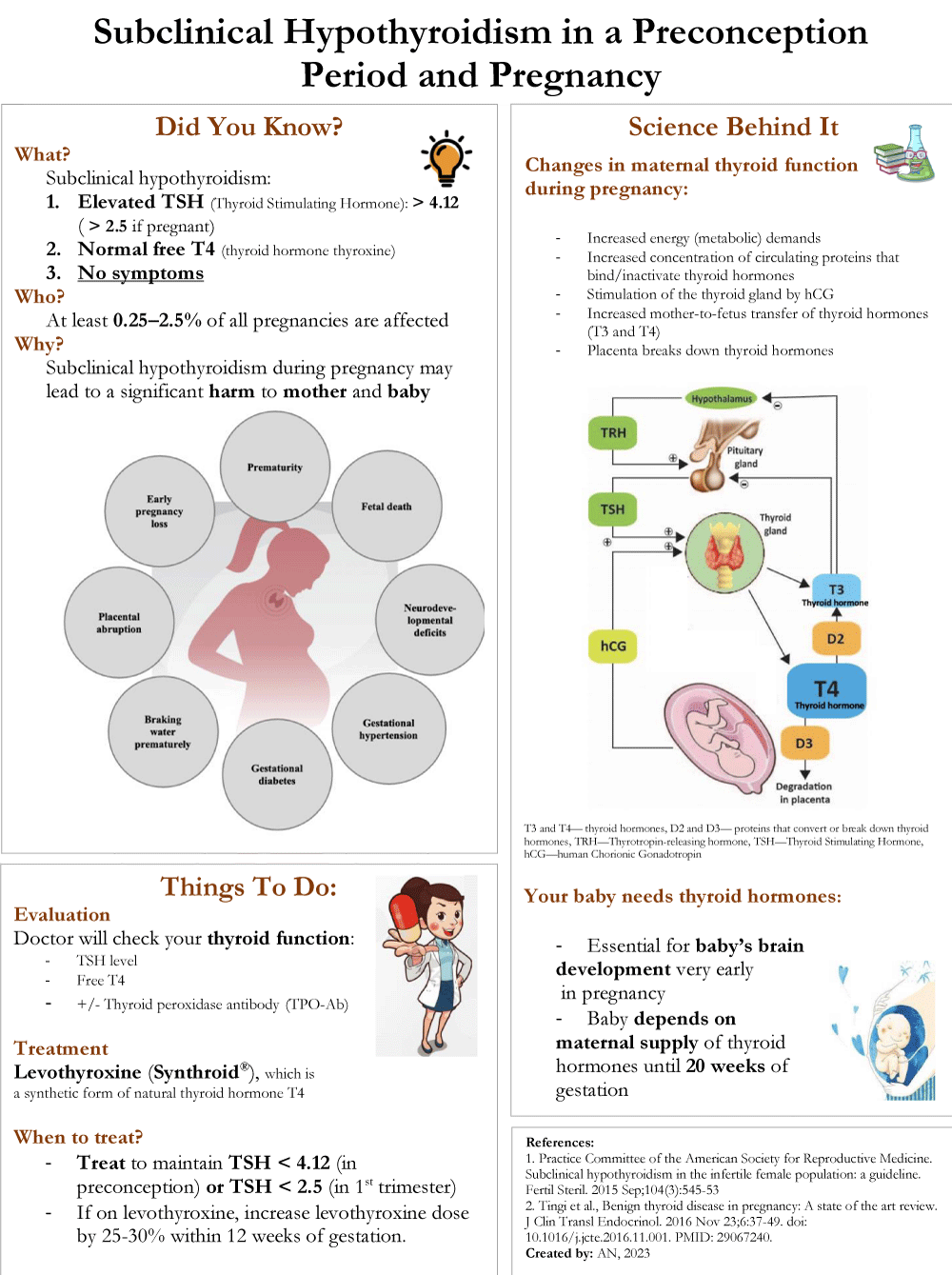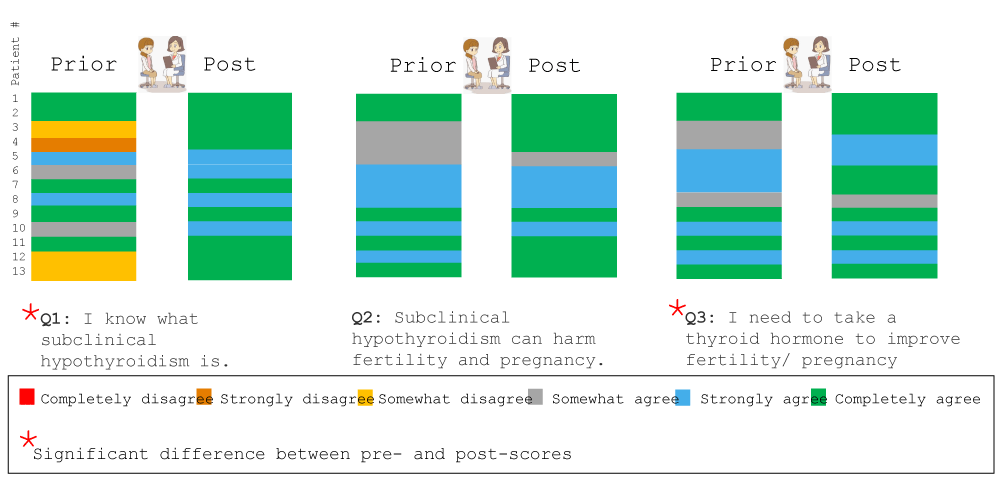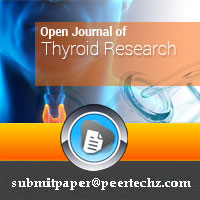Open Journal of Thyroid Research
Patient education about subclinical hypothyroidism in preconception and early pregnancy
Anastasia Navitski1*, Rebecca Joseph1, Alexandria Riedel1, Kaitlyn Kennedy1, Christian Reinhardt1 and Larisa Gavrilova-Jordan2
2Reproductive Endocrinology and Infertility, Medical College of Georgia at Augusta University, Augusta, GA, USA
Cite this as
Navitski A, Joseph R, Riedel A, Kennedy K, Reinhardt C, Gavrilova-Jordan L. (2024) Patient education about subclinical hypothyroidism in preconception and early pregnancy. Open J Thyroid Res 7(1): 001-005. DOI: 10.17352/ojtr.000015Copyright License
© 2024 Navitski A, et al. This is an open-access article distributed under the terms of the Creative Commons Attribution License, which permits unrestricted use, distribution, and reproduction in any medium, provided the original author and source are credited.Introduction: The diagnosis and treatment of Subclinical Hypothyroidism (SCH) in preconception and early pregnancy has been an area of debate. The challenge of managing SCH further lies in often suboptimal patient understanding of the condition given its asymptomatic state. This study aimed to assess whether patient education materials could improve patient knowledge about SCH and encourage compliance with clinical management. Furthermore, we reviewed the current recommendations for the diagnosis and treatment of SCH in preconception and pregnancy.
Methods: Patients who presented to the Reproductive Medicine and Infertility Clinic, Augusta University, Georgia, USA between July 2023 and February 2024, who were attempting to conceive or in early pregnancy, and who met the SCH diagnostic criteria were invited to participate in this prospective cohort study. The study participants completed a pre-education and demographic questionnaire, underwent a brief consultation with a provider who reviewed the SCH information sheet, and then completed the post-education questions. Paired Wilcoxon rank-sum tests of significance were used to evaluate the change in pre- and post-education scores.
Results: Thirteen patients completed the survey. There was a range of pre-existing knowledge about SCH in our study population. Most patients acquired knowledge about SCH diagnosis (Q1: P = 0.013) during the counseling. Patient education improved their attitudes about the treatment of SCH with levothyroxine (Q3: P = 0.029).
Conclusion: While the clinical guidelines on diagnosis and treatment of SCH in preconception and early pregnancy continue to evolve as more research becomes available, patient education can significantly improve their knowledge about the condition and encourage compliance with treatment if indicated.
Abbreviations
ASRM: The American Society for Reproductive Medicine; SCH: Subclinical Hypothyroidism; TSH: Thyroid-Stimulating Hormone; T4: Thyroxine
Introduction
Thyroid disorders affect nearly 14% of women, and the pleiotropic effect of thyroid hormone has a multitude of implications regarding reproductive health [1]. Overt hypothyroidism is known to be associated with adverse reproductive outcomes, including obstetric and fetal complications, increased incidence of infertility, and miscarriage [2]. Subtle thyroid dysfunction in the infertile female population has been an area of debate in the last decade. The guidelines on the definition, screening, and treatment of Subclinical Hypothyroidism (SCH) have been evolving over time based on available evidence [2,3]. Furthermore, the challenge of managing SCH in infertility and early pregnancy lies in frequently suboptimal patient understanding of the condition given its asymptomatic state. Patient education has been demonstrated to significantly improve patient knowledge and compliance with treatment across a broad range of conditions and disease severities [4]. In this study, we aimed to assess whether written patient education materials could improve patient knowledge about SCH and encourage compliance with clinical management.
Materials and methods
Patient recruitment and data collection were performed at the Reproductive Medicine and Infertility Clinic, Medical College of Georgia at Augusta University, Georgia, USA. The study was approved by the Institutional Review Board (Protocol #2198785). Reproductive-age women with infertility or prior history of pregnancy loss who were attempting to conceive, TSH > 4.12 mU/L, and normal free T4, and women in early first-trimester pregnancy, TSH > 2.5 mU/L, and normal free T4, who presented to the clinic between July 2023 and February 2024, participated in the study. Following verbal informed consent, the study participants completed an anonymous pre-education three-question survey and a demographic questionnaire. Next, all patients underwent a consultation with a provider (AN, AR, KK, or CR) who reviewed written information materials including picture diagrams, which were created based on the 2015 American Society for Reproductive Medicine (ASRM) guidelines on diagnosis and management of SCH (Supplemental 1)
[2]. Before leaving the clinic, all participants completed four post-education questions. All patients who met the study inclusion criteria agreed to participate.
The survey contained three parts: pre-education, a demographic questionnaire, and post-education. The pre-education part had three questions: “Q1. I know what SCH is” and “Q2. SCH can adversely affect fertility and pregnancy” to assess knowledge about the condition; “Q3. I need to take thyroid hormone to optimize fertility/pregnancy” to assess attitudes on treatment and compliance. The post-education part had the same three questions and “Q4: Educational materials were useful in the understanding of the clinical condition,” which was to assess patients’ attitudes on the use of the printed educational materials during counseling. Each item was scored from 0 (“completely disagree”) to 5 (“completely agree”) on a 5-point Likert scale. The score for each item was linearly transformed to a scale between 0 and 100. The collected demographic data included patient-reported age, race, and education. The survey was anonymous, and no patient identifiers were collected.
Statistical analysis was performed using R 4.1.0 (R foundation, Vienna, Austria). Paired Wilcoxon rank sum tests of significance were performed for comparison of non-parametric data. A significance level of p < .05 was used to identify the improvement in scores after patient education was provided.
Results
Thirteen women participated in the study. Demographic information is presented in Table 1. The mean age of study participants was 31 years with the range of 22 to 38 years. The comparison of pre-and post-education scores is presented in Table 2 and illustrated in Figure 1. There was a range of pre-existing knowledge about SCH in our study population: the median total pre-education score was 80 (95% CI: 40 - 100). Most patients acquired knowledge about SCH diagnosis (Q1: P = 0.013) during the counseling. The p-value for Question 2, which also assessed patient knowledge, was not statistically significant at 0.051, likely due to a small sample size. Patient education improved their attitudes about the treatment of SCH with levothyroxine (Q3: P = 0.029). Most patients found educational materials useful for a better understanding of the clinical condition.
Discussion
SCH is a state of subtle, often asymptomatic, thyroid dysfunction [3]. The management of SCH in women with infertility, women with prior pregnancy losses, or during pregnancy remains an area of debate with the most recent recommendations, released by ASRM, changed to advocating against screening and treatment for asymptomatic SCH. While the guidelines continue to evolve as more research becomes available, patients’ understanding of the SCH diagnosis and compliance with treatment can be enhanced by evidence-based patient-centered education. In this study, we demonstrated that the clinical guidelines simplified into printed educational materials improved patients’ knowledge about the condition and encouraged compliance with treatment.
SCH is defined by a serum TSH above the upper reference limit and a normal free T4, in the setting of stable thyroid function, a normal hypothalamic-pituitary-thyroid axis, and no recent illness [5]. 4% - 8% of a reproductive age population have TSH > 4.5 – 5.0 mIU/L and normal free T4, meeting the classic criteria for diagnosis of SCH [6,7]. The upper limit of normal for TSH in early pregnancy was defined as 2.5 mIU/L, which is due to human chorionic gonadotropin binding to the TSH receptor [2,8]. Most recently, ASRM redefined the reference range advising on the use of laboratory-specific values for pregnant and nonpregnant patients. When no reference range is available, a TSH of 4.12 mIU/L can be used as the upper limit of normal for nonpregnant patients; the limit should be reduced by 0.5 mIU/L for pregnant patients in the first trimester [3].
Thyroid hormones play a crucial role in regulating metabolism, growth, and energy expenditure, which are all vital for a healthy pregnancy [9,10]. The fetal thyroid gland starts producing thyroid hormone only after 10 weeks - 13 weeks of gestation. Hence, maternal thyroid hormone is essential during the initial stages of pregnancy. A primary hormone that is transported via the placenta is thyroxine (T4), not triiodothyronine (T3); thus, the treatment of SCH in pregnancy is always with levothyroxine [9,10]. It remains controversial whether subclinical hypothyroidism has an impact on conception and pregnancy outcomes. Treatment recommendations for SCH in a preconception period and early pregnancy vary between different professional societies [3,5,11]. In accordance with the 2015 ASRM guidelines, our clinical practice had been to test TSH in infertile women and women with recurrent pregnancy loss attempting pregnancy and to consider treatment for SCH in the preconception period and the first trimester until the recent release of the updated ASRM guidelines in 2024 [2,3]. After reviewing available data on the role of SCH in reproduction, ASRM concluded that SCH had not been associated with an increased risk of miscarriage, adverse obstetric outcomes, and suboptimal neurodevelopment in the offspring; thus, maternal thyroid function should not be routinely checked [3,12]. Per the updated ASRM guidelines, SCH should not be treated with levothyroxine in a preconception period and early pregnancy with the goal of reducing the risk for pregnancy loss or improving life-birth outcomes. Importantly, screening of thyroid function is still recommended for patients who are symptomatic or at increased risk. Targeted thyroid function and autoimmunity screening may be considered in women with a history of recurrent pregnancy loss. Additional high-quality research is needed to evaluate the role of SCH in patients with infertility, ovulation dysfunction, and those undergoing IVF therapies.
When treatment is recommended, patient participation and compliance are imperative [13]. Poor understanding of the condition can lead to suboptimal compliance with a medication regimen. It is particularly relevant to the management of asymptomatic conditions [4,14]. Without noticeable symptoms of hypothyroidism, patients may be less motivated to adhere to treatment or may not fully understand the significance of managing a chronic condition. Research has shown that patient education markedly enhances treatment adherence across various conditions and levels of disease severity [4].
In this study, we designed patient handouts on SCH diagnosed in a preconception period or early pregnancy based on the ASRM 2015 guidelines to facilitate patient education and counseling. The analysis of our data demonstrated that the guidelines simplified into printed educational materials improved patients’ knowledge about SCH and encouraged compliance with clinical management, with both being statistically significant. Of note, Question 2 assessed the change in patient knowledge about how SCH can affect fertility and pregnancy and did not meet the threshold for statistical significance, which was most likely due to the low power of the study, but we also cannot exclude that patients had some preexisting knowledge about the controversy on SCH in pregnancy or the educational materials were not clear enough or convincing to address that aspect of clinical recommendations. Most patients found the handouts useful and informative.
There are several limitations to our study, which include a single-center small sample size, no comparison group, and a possibility of pre-existing knowledge that patients had about SCH diagnosis and management. We terminated our study early given that the updated management guidelines became available advising against the treatment of asymptomatic SCH with levothyroxine; thus, the study was underpowered, and we were unable to stratify the patients based on demographics, which could have accounted for some of the confounding bias.
Importantly, no strong evidence is available on the screening and treatment of SCH in patients with infertility, irregular menstrual cycles, ovulatory dysfunction, a history of early pregnancy losses, or those receiving IVF therapies [3,15,16]. Hence, the findings of this study remain relevant to the management of SCH in this patient population.
Conclusion
Understanding the diagnosis of SCH and its implications in pregnancy can be challenging for patients given its asymptomatic state. We demonstrated that patient education supplemented with printed educational materials, which summarized the clinical guidelines on diagnosis and treatment, significantly improved patients’ knowledge about the condition and encouraged compliance with clinical management. We conclude that reproductive-age women with infertility, recurrent pregnancy loss, or early pregnancy are more likely to actively participate in the management of SCH when they feel informed and empowered.
Informed consent
Informed consent was obtained from the patients prior to an anonymous survey administration.
Author contributions
Conceptualization, Data Curation, Writing-original draft: A.N., R.J., L.G.J.
Provision of patients: L.G.J.
Statistical analysis: A.N.
Final approval of manuscript: All authors
- Brown EDL, Obeng-Gyasi B, Hall JE, Shekhar S. The Thyroid Hormone Axis and Female Reproduction. Int J Mol Sci. 2023 Jun 6;24(12):9815. doi: 10.3390/ijms24129815. PMID: 37372963; PMCID: PMC10298303.
- Practice Committee of the American Society for Reproductive Medicine. Subclinical hypothyroidism in the infertile female population: a guideline. Fertil Steril. 2015 Sep;104(3):545-53. doi: 10.1016/j.fertnstert.2015.05.028. PMID: 26239023.
- Practice Committee of the American Society for Reproductive Medicine. Electronic address: asrm@asrm.org. Subclinical hypothyroidism in the infertile female population: a guideline. Fertil Steril. 2024 May;121(5):765-782. doi: 10.1016/j.fertnstert.2023.12.038. Epub 2023 Dec 30. PMID: 38163620.
- Gold DT, McClung B. Approaches to patient education: emphasizing the long-term value of compliance and persistence. Am J Med. 2006 Apr;119(4 Suppl 1):S32-7. doi: 10.1016/j.amjmed.2005.12.021. PMID: 16563940.
- Garber JR, Cobin RH, Gharib H, Hennessey JV, Klein I, Mechanick JI, Pessah-Pollack R, Singer PA, Woeber KA; American Association of Clinical Endocrinologists and American Thyroid Association Taskforce on Hypothyroidism in Adults. Clinical practice guidelines for hypothyroidism in adults: cosponsored by the American Association of Clinical Endocrinologists and the American Thyroid Association. Endocr Pract. 2012 Nov-Dec;18(6):988-1028. doi: 10.4158/EP12280.GL. Erratum in: Endocr Pract. 2013 Jan-Feb;19(1):175. PMID: 23246686.
- Canaris GJ, Manowitz NR, Mayor G, Ridgway EC. The Colorado thyroid disease prevalence study. Arch Intern Med. 2000 Feb 28;160(4):526-34. doi: 10.1001/archinte.160.4.526. PMID: 10695693.
- Hollowell JG, Staehling NW, Flanders WD, Hannon WH, Gunter EW, Spencer CA, Braverman LE. Serum TSH, T(4), and thyroid antibodies in the United States population (1988 to 1994): National Health and Nutrition Examination Survey (NHANES III). J Clin Endocrinol Metab. 2002 Feb;87(2):489-99. doi: 10.1210/jcem.87.2.8182. PMID: 11836274.
- Hernández M, López C, Soldevila B, Cecenarro L, Martínez-Barahona M, Palomera E, Rius F, Lecube A, Pelegay MJ, García J, Mauricio D, Puig Domingo M. Impact of TSH during the first trimester of pregnancy on obstetric and foetal complications: Usefulness of 2.5 mIU/L cut-off value. Clin Endocrinol (Oxf). 2018 May;88(5):728-734. doi: 10.1111/cen.13575. Epub 2018 Mar 9. PMID: 29453792.
- Patel J, Landers K, Li H, Mortimer RH, Richard K. Thyroid hormones and fetal neurological development. J Endocrinol. 2011 Apr;209(1):1-8. doi: 10.1530/JOE-10-0444. Epub 2011 Jan 6. PMID: 21212091.
- Moog NK, Entringer S, Heim C, Wadhwa PD, Kathmann N, Buss C. Influence of maternal thyroid hormones during gestation on fetal brain development. Neuroscience. 2017 Feb 7;342:68-100. doi: 10.1016/j.neuroscience.2015.09.070. Epub 2015 Oct 3. PMID: 26434624; PMCID: PMC4819012.
- Thyroid Disease in Pregnancy: ACOG Practice Bulletin, Number 223. Obstet Gynecol. 2020 Jun;135(6):e261-e274. doi: 10.1097/AOG.0000000000003893. PMID: 32443080.
- Casey BM, Thom EA, Peaceman AM, Varner MW, Sorokin Y, Hirtz DG, Reddy UM, Wapner RJ, Thorp JM Jr, Saade G, Tita AT, Rouse DJ, Sibai B, Iams JD, Mercer BM, Tolosa J, Caritis SN, VanDorsten JP; Eunice Kennedy Shriver National Institute of Child Health and Human Development Maternal–Fetal Medicine Units Network. Treatment of Subclinical Hypothyroidism or Hypothyroxinemia in Pregnancy. N Engl J Med. 2017 Mar 2;376(9):815-825. doi: 10.1056/NEJMoa1606205. PMID: 28249134; PMCID: PMC5605129.
- McClung B. Principles of Patient and Family Education and Support. The Bone and Mineral Manual. Elsevier. 2005; 175–7.
- Miller NH. Compliance with treatment regimens in chronic asymptomatic diseases. Am J Med. 1997 Feb 17;102(2A):43-9. doi: 10.1016/s0002-9343(97)00467-1. PMID: 9217586.
- Practice Committee of the American Society for Reproductive Medicine. Evaluation and treatment of recurrent pregnancy loss: a committee opinion. Fertil Steril. 2012 Nov;98(5):1103-11. doi: 10.1016/j.fertnstert.2012.06.048. Epub 2012 Jul 24. PMID: 22835448.
- Bernardi LA, Cohen RN, Stephenson MD. Impact of subclinical hypothyroidism in women with recurrent early pregnancy loss. Fertil Steril. 2013 Nov;100(5):1326-31. doi: 10.1016/j.fertnstert.2013.07.1975. Epub 2013 Aug 15. PMID: 23954357.
Article Alerts
Subscribe to our articles alerts and stay tuned.
 This work is licensed under a Creative Commons Attribution 4.0 International License.
This work is licensed under a Creative Commons Attribution 4.0 International License.




 Save to Mendeley
Save to Mendeley
